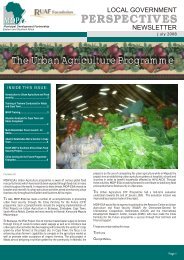the africa local government action forum (algaf) - Municipal ...
the africa local government action forum (algaf) - Municipal ...
the africa local government action forum (algaf) - Municipal ...
Create successful ePaper yourself
Turn your PDF publications into a flip-book with our unique Google optimized e-Paper software.
Pro-poor <strong>government</strong>Pro-poor <strong>government</strong> is context specific and it depends on a number of factors includinghow defines poverty. Poverty reduction does not only require good policies butdeveloping <strong>the</strong> capacity of <strong>the</strong> poor people to influence policies, and to holdaccountable those make decisions.The market led approach to pro-poor governance of business development aims toenable <strong>local</strong> economies to adjust more successfully to macro-economic reforms andemphasize <strong>the</strong> goals promoting individual self-reliance, entrepreneurship, expansion of<strong>the</strong> market, competitiveness, reduction of unemployment and sustainable growth. Bycontrast, <strong>the</strong> market-critical or pro-poor approach of community developmentrepresents a bottom up approach geared to goals of achieving <strong>local</strong> self, reliance,empowerment, participation, <strong>local</strong> cooperation, and environmental sustainability.Governments ApproachThe South African Government’s approach is broad targeting emphasizing <strong>the</strong> deliveryof key services to poorer people such as housing, health, education and grants. This ishowever, a mammoth task, as evidenced by backlogs which have resulted in servicedelivery protests.In <strong>the</strong> housing sector <strong>the</strong> 2009 Provincial Budget Review makes <strong>the</strong> point that<strong>government</strong> has provided approximately 2.6 million housing units since 1994 and anestimated 1.8 million households still require some form of public support to accessacceptable housing. The 2.6 million houses came at a cost of R 49 billion, at a grossaverage cost of R18 850 per unit and an annual delivery rate of 200 000 units a year.Regarding <strong>the</strong> education sector, South Africa spends a large proportion of its budget oneducation. The post-1994 era has seen <strong>the</strong> education system drastically transformed inan attempt to ensure an equitable and quality education. Schooling has been madecompulsory for all children aged between 7 and 15 years. A no-fee schools policy wasestablished in 2008 covering 13 912 schools benefiting about 5 million pupils.The presenter also gave examples of <strong>the</strong> health sector and <strong>the</strong> social grants transfers as<strong>government</strong> approaches to pro-poor <strong>government</strong>.Civil Society Organizations’ ApproachThis is based on four pillars namely research, advocacy, capacity development andlitigation. A lot of work has been done by NGOs in South Africa regarding Research andCapacity Development for pro-poor <strong>government</strong>. This includes work done by <strong>the</strong> BudgetInformation Service (BIS) as well as <strong>the</strong> Children’s Budget Unit (CBU).3





